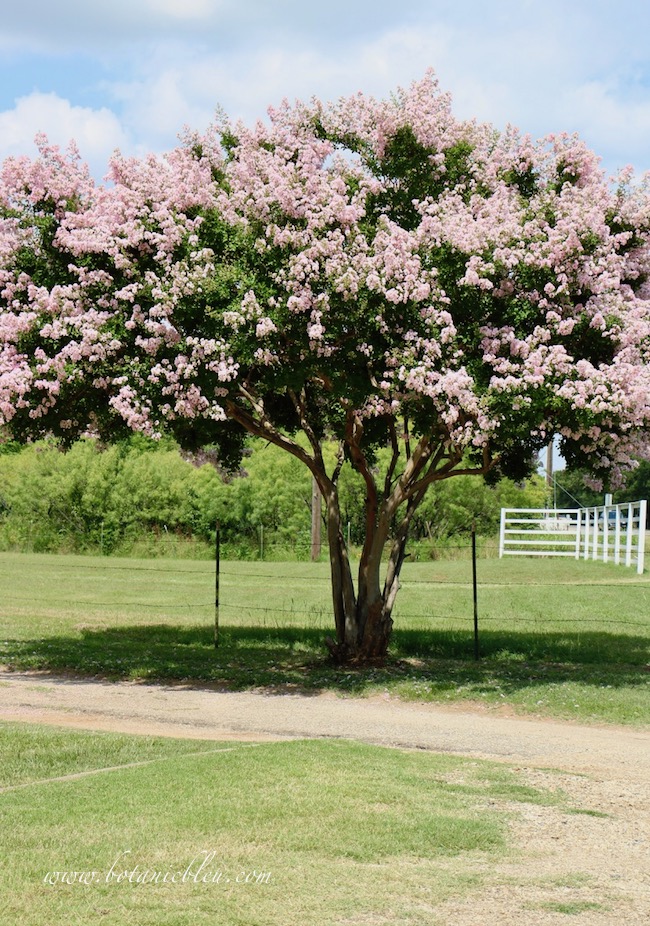A stunning pink crepe myrtle tree grows on a small farmholding down a country road near me. The tree is an example of why crepe myrtles have been staples in Deep South gardens and yards for generations.
For over twenty years I have admired the beautiful tree covered in fluffy pink blossoms as I travel from my home to the closest town for shopping.
P i n k C r e p e M y r t l e
W h y S o u t h e r n G a r d e n e rs L o v e T h e m
❀ Heat & Drought Tolerant
This tree's location is a clue to how heat and drought tolerant crepe myrtles are. Located at the end of a long driveway, the tree receives little supplementary watering according to the owners.
In north Texas, summers are long, hot, and dry, punctuated by occasional thunderstorms often spawned by distant hurricanes hundreds of miles away in the Gulf of Mexico. Occasional storms mean once every two to four weeks during mid-June through September. Not every hurricane's inland path heads to north Texas. And, some thunderstorms originate from the west or north, not from the Gulf.
Nonetheless, local municipalities and commercial properties often use crepe myrtles in green spaces. That is a telltale sign of how little extra water crepe myrtles require. However, the trees do need supplementary watering to thrive, but not as much as some other ornamental trees.
❀ Blooms
The blossoms' petals resemble crinkled crepe paper and form large clusters at the end of the tree's branches. Beautiful up close and from a distance, the blooms are quite large and showy.
Recently, I read an article that called crepe myrtles the 'lilac of the south.' Lilacs require cold winters and are not recommended for gardening heat Zones 7 and higher. On the other hand, crepe myrtles do not like cool weather and prefer heat. One of the reasons crepe myrtles do not bloom well is because of cool temperatures.
If you are a transplanted northern gardener to the South, you may want to use crepe myrtles in your landscape where you used lilacs in the North.
Crepe myrtles are available in several colors. Pink, white, magenta, and shades of purple mean you can find a color to blend with your garden's colors.
❀ Blooming Season
Crepe myrtles bloom on new growth from late spring through fall. This tree was at its blooming peak in these photos taken on June 30 last summer.
Interesting seed pods remain after the plant loses its blooms and leaves each fall. The bark of the tree also provides an interesting texture during winter.
The longevity of the blooming season is one of the reasons the plant is sought for home gardens. In the height of summer when many blooming plants go dormant from the heat, crepe myrtles continue to provide color.
❀ Fall & Winter
Often the leaves turn shades of red as the weather cools down each fall. True the leaves will not be brilliant red like New England trees, but the leaves do add fall color in a region where fall color is sparse.
❀ Pruning
Since crepe myrtles bloom on new growth, pruning helps new blooms to form each spring. The best time to prune is in winter. Avoid pruning late to prevent losing blooms to come.
Heavy pruning in winter seems to promote vigorous new growth of branches in the spring. However, trim growth along the large branches instead of cutting the tops off large trunks. Topping the trees produces spindly new branches that cannot support large blooms. Plus, the tree will look misshapen. Consult a local nursery for advice on how best to shape the tree.
Trim lower branches from the tree trunks to create a lovely canopy of flowers above three or four trunks like the beautiful pink crepe myrtle.
Remove suckers that sprout at the base of the tree anytime to prevent multiple trunks forming and to conserve water for the tree.
❀ Crepe or Crape?
The traditional Southern spelling is crepe myrtle since the flowers resemble crepe paper. However, the scientific name is largerstroemia crape myrtle, and across the United States the tree is commonly known as a crape myrtle.
Both spellings are accepted and depend upon personal preference in everyday use. Crape Myrtle would be the preferred spelling for formal references since that is the scientific name.
Either way, crepe myrtles are loved by Southern gardeners for their profuse flowers and ease of growing. My earliest memories of my grandmother's garden include a huge crepe myrtle filled with flowers all summer.
Be safe, and enjoy summer flowers... at home and from driving your car around nearby neighborhoods.
More posts you may enjoy...
French Country White Urn filled with dark pink crepe myrtles
New Backyard Retaining Wall With Old World Charm Crepe myrtles survived the renovation.
Thank you for reading Botanic Bleu!
I hope you find beauty and useful information in every post.








